Are those people and things really leaving us?
Editor’s note: This article is from WeChat public account “Silicon said” (ID: silicon_talks) , The author laughed.
One
Wine,
Mortal is drunk.
Immortals can make the world.
Li Bai has a hundred poems, sleeping in a restaurant in Chang’an. Zhang Xu’s three cups of grass saints, waving the paper like a cloud of smoke. The earliest integrated circuit designer was also an alcoholic, an alcoholic who loved to raise his middle finger, and an alcoholic who did not report without drinking—Robert Widlar.
In 1963, five years after the IC was “invented”, the drunk Widlar ran to a Silicon Valley company and pointed to his nose to say that your circuit design was Bullshit. This kind of behavior can be called ground breaking, because one of the owners of this company invented the integrated circuit of true meaning, his name is Bob Noyce. It’s a pity that Noyce hasn’t lived as long as Jack Kilby, and didn’t wait for the day when the Nobel Prize fell down. Naturally, that company is the Fairchild Fairchild Semiconductor, founded by eight insurgents such as Noyce after the inventor of the transistor, Shockley.
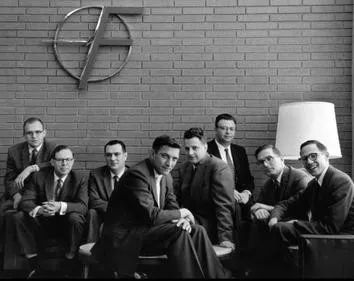
Traitorous Eight, betrayed Shockley and founded Fairchild Semiconductor
Then Fairchild hired Widlar to help them design analog circuits. (Sounds like masochism?)
Next, Widlar said:
We need an op amp, so we have μA702,
A band gap datum is needed, so LM113,
We need power amplification output, so we have μA709,
You need a linear regulator (LDO), so you have the LM100.
(Those μA are very familiar, yes, they are the ancestors of μA741 in the foundation of analog circuit. The μA series op amps have ruled human integrated circuit analog chips for 20 years.)
Semiconductors in Silicon Valley hate this self-righteous drunkard, but have to admire that genius. Admiration for National Semiconductor (the employer of National Semiconductor, Wildar a few years later, acquired by TI a few years ago) uses Widlar’s iconic middle finger to defy opponents.

(this picture will be uncomfortable for some readers)
Then, Widlar said, I am going to retire at the age of 33. There is a short article written about the ninefold realm of analog circuits. The highest realm is to live on an island in the Pacific to fish, and then glance at the glorious circuit of the earth occasionally. This is Widlar’s life after retirement. Of course, he still joins the WTO occasionally. For example, in 1981, he accidentally founded Linear Technology (Linte, which was acquired by ADI the previous two years).
In 1991, Widlar died of a heart attack caused by long-term alcoholism. At 55, his life was drunk.
Second
Widlar bohemian American heroism has many mysteries. In 1969, a young Ph.D who just graduated from Arizona joined Fairchild Semiconductor with an infinite vision of Widlar.
Unfortunately at that time, Widlar had already left Fairy Tong, and when he left, he still pointed at the company’s big VP Gordon Moore (yes, that is Moore’s Law) and said: Silly X will do digital circuits ( Original words: Every idiot can count from zero to one). Because Moore believes Fairchild should focus its strategy on digital circuit development. Soon, Noyce and Moore also left Fairchild to start their British empire (intel), which is naturally a second story.
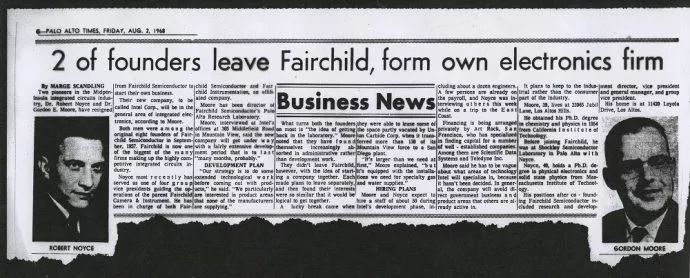
In 1971, the immortal boy without the backbone had already gone through the storms and suffered a Great Depression. This year, the fanboy met a professor from a nearby school, and the professor said that they lacked a teacher who taught circuits to teach circuit basics.Basic theory, in fact, he did not want to go to find a pick-up man. It happened that the fanboy had just had a son, so it would be better to go back and change to a stable job.
That school is called UC Berkeley, and the professor is Donald Pederson. The highest honor of the IEEE Solid State Circuit Association (the solid state circuit of the ISSCC / JSSC) is called the IEEE Donald Pederson Award. It is awarded annually by the IEEE Chairman at ISSCC to commemorate the founder of the chip design, Donald Pederson .
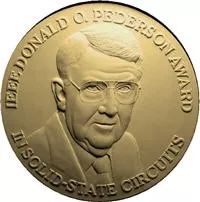
First of all, my fanboy, he finally inherited the mantle of Widlar, and started the golden age of analog circuits. He and his students invented most of the world’s existing analog circuits / digital-analog hybrid integrated circuits, including amplifiers, switched capacitor filters, sampling circuits, and successive comparison / pipelined / Delta-Sgima / Time-interleaved ADC. More importantly, he wrote the well-deserved “Scripture” in the field of analog circuit design-Analysis and Design Analog Integrated Circuits, which has been published in five editions. (Although one of his students wrote a textbook similar to the “Scripture Story”, it seems to be more widely spread because it is easier to understand, but the status of the Bible cannot be challenged).
He is Paul Gray, former vice president of UC Berkeley, and a member of both houses of the United States.
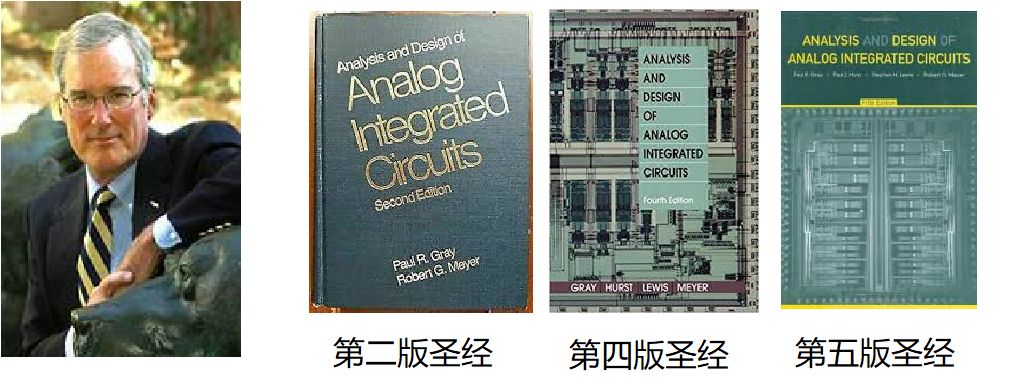
Three
Back to Pederson, the whole solid-state circuit is willing to consider him a brother, not because of his circuit design ability, but because he is willing to give a grade to a class that has never been taught.
In 1969, Ron Rohrer, who was not very happy in Fairchild, planned to go to UC Berkeley to have a side job and relax. It turned out that the teacher who took this class went to be the head of the department, so he followed him. In this course, he arrangedFor an unprecedented assignment, write a circuit simulator that supports DC / AC / timing analysis, support for various semiconductor devices, and then invite Don Pederson to be a judge and decide who to give A to. Pederson’s most satisfied student is called Larry Nagel, who called his course design Circuit Analysis of Nonlinear Circuits, Excluding Radiation, or CARRER. It is often said that the art of naming is lacking, so do these nerds need to complement cancer? (Cancer is translated into cancer.)

Later, Pederson accepted this student as a PhD to further optimize CANCER. Of course, the first step in optimization was to give it a nice name. CANCER was quickly renamed Simulation Program with Integrated Circuit Emphasis, or SPICE for short. SPICE as a paper, there was nothing good at the time, only in 1973, a conference paper of Midwest Circuits Theory (now this will be called MWSCAS, is also the starting point of the academic irrigation of Xiaobian, now it seems suddenly burst into success Sense.)
However, the “lost” in academic circles has not hindered SPICE’s brilliance. To this day, SPICE is still affecting every chip. All EDA manufacturers provide SPICE-based emulators, Cadence has PSPICE and Spectre, Synopsys has HSPICE, and domestic Huada Jiutian has ALPS (Accurate Large-capacity Parallel Spice, the only integrated circuit emulator on the market that supports GPU parallelism). As mentioned above, Linear Technology is still providing a free version of LTSPICE for circuit enthusiasts.
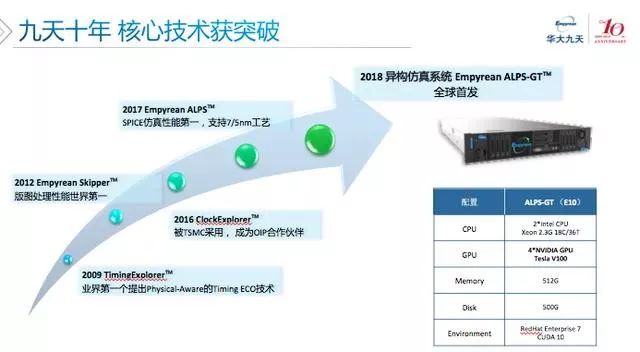
** Cannot be counted as an advertisement ** The ALPS-GT emulator released by China EDA manufacturer Huada Jiutian in 2018
Became the first SPICE running on the GPU, the performance surpassed HSPICE and Spectre
SPICE is the mainstay of the entire transistor-level design and the cornerstone of the EDA discipline of integrated circuits. The reliance of circuit designers on SPICE today has made it impossible for us to imagine, in the years without SPICE, what kind of wisdom did Widlars use to build a complete operational amplifier on a Wafer silicon chip.
Why does SPICE succeed? I think there are two answers:
1) Open source, open source, and open source. (Important thing said three times)
2) As an emulator, SPICE makes the circuit design “civilian”. Before SPICE, only geniuses like Widlar could design beautiful circuits; but with SPICE, mediocre can pass a new-born animal-SPICE Monkey (broadly refers to those who do not understand the circuit principle but can still blindly pass simulation. Solution) to design high-performance circuits.
By the way, those analog circuit bosses do n’t discriminate against SPICE Monkeys anymore. Today ’s AI reinforcement learning / AlphaZero uses this splash monkey, SPICE can run GPU again, and can grab you in minutes. Rice bowl.
Four
Novee and Moore made a big news on November 15, 1971, two years after leaving Fairchild-Intel released the first human microprocessor chip, codename 4004, because it is a 4-bit Processor chip. Less than a year later, Intel released 8008, the first 8-bit processor. The other epoch-making significance of these two chips lies in the use of MOS tubes. The success of 4004/8008 also announced that TTL logic gates based on bipolar transistors have ended in large-scale integrated circuits!
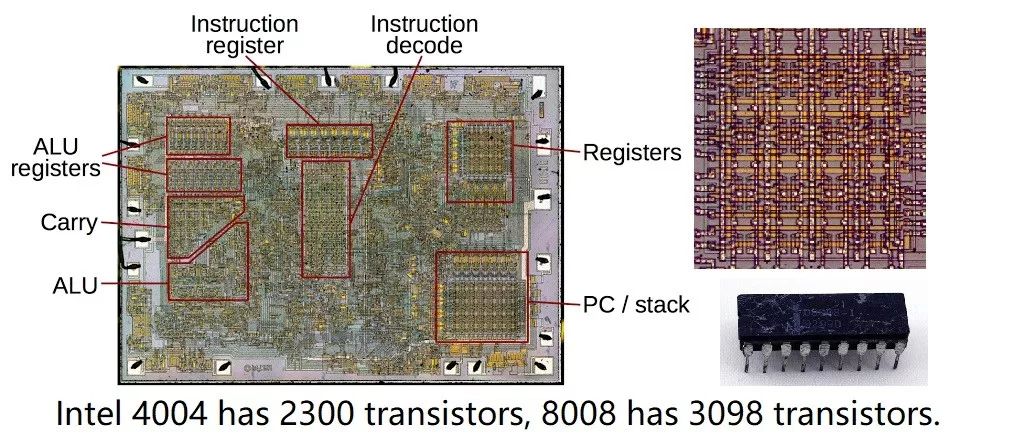
Intel 8008 chip layout and packaging
At that time, Intel ’s more successful battlefield was memory chips, especially DRAM. Therefore, the circuit of the register part used by 8008 (including various types of Register and PC-is instruction register) uses its own DRAM design. These things are also the only ones that look close from the layout photo (upper right part of the picture above).Part of modern Very Large Scale Integrated Circuits.
It was also from this time that the entire Silicon Valley realized that the “Cramming more components onto integrated circuits” written by Intel’s boss 6 years ago started to be a little bit different.
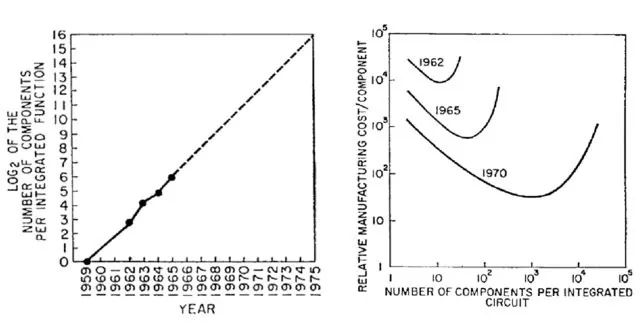
Professor Carver Mead of the California Institute of Technology first came forward, and recommended that the hydrological conclusion above be named “Moore’s Law”, which is now known to every chip person as Moore’s Law. Then, Intel asked him to be a consultant for a long time. Doesn’t that sound like the scenes of the gui martial arts genius in the martial arts novels?
4004 and 8008 are landmarks, but the shortcomings are obvious-they are all drawn by hand. The number of transistors they use is only around two or three thousand, and manpower is ultimately limited. So, the question comes-how do chip designs move toward 20,000, 30,000, 2-3 million, 2-3 million, 2-3 million … transistors according to Moore’s Law?
Five
The people who solved this problem originally planned to leave the hardware pit in the early 1970s to become code farmers.
It’s not because she’s mediocre, but too outstanding. At the age of 27, she was recognized as a genius of computer architecture, and invented the most basic CPU speed-up method-Out-of-order Dynamic Scheduling architecture. Before it appeared, before everyone knew what the Von Neumann architecture was, IBM built the first human superscalar computer.
There is a small mistake. When young is famous, she should be him. Later, he changed to her.
Because of the transsexual surgery, IBM fired the ladies’ big brother, just like the British can’t stand Turing being gay, no matter how good you contribute. Affected by this, after the transgender, she intends to remain anonymous and forget her. In a novel that I love to read, I found the name of my favorite heroine and pressed it on my head. Such a brand-new Lynn Conway was born. As for this name, it has almost disappeared, and it is not a test.

Lynn Conway with its charm, taken in 2000
After the Yangtze River pushed forward, Conway suddenly found out that after the birth of 4004, the era of TTL is gone. Her MOSFET architecture engineer who does not understand is about to be laid off. So she gave up the advantages and disadvantages of Fairchild System Architect and went to Xerox (that printer company) to write software.
Coincidentally, Professor Mead, who was famous for Moore’s law, turned to Xerox and wanted to write software to complete the wiring in a multi-device environment.
A few years later, Conway completed the second major achievement of his life in 1978-he proposed a new digital circuit / VLSI design method, which can be briefly described as two levels:
(1) The layout uses a library of digital standard cells that are the same height, symbolized with stick diagrams, and then abstracted the door-level model.
(2) The routing grid is based on the feature size lamda. The algorithm is simple and can be reduced according to Moore’s Law.
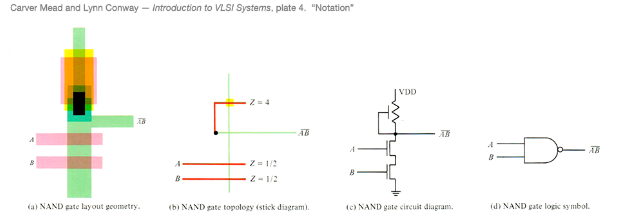
These two are considered to be the starting points for VLSI methodology. The original digital circuit design flow was quickly divided into the logical expression of the abstraction layer and the layout implementation of the physical layer, which is the RTL front-end and layout back-end that we commonly use. Today, digital circuits still follow this pattern of division of labor.
This small step seems to be the biggest step in chip history!
With the methodology, the EDA toolchains such as synthesis / automatic layout are gradually formed;
With the methodology, the interface between circuit design and process manufacturing is completely clear, which promotes a new tape-out mode-MPW, small batch proofing of different designs / the same process (DARPA builds on this achievement MOSIS, focusing on the MPW design process);
With the methodology and MPW, the current mainstream chip model of Fabless IC Design House + Foundry is available.
LargeComplex to simple, it may be possible to summarize the methodology of Lynn Conway.
Postscript
In fact, many things happened in 1963-1978, such as a DRAM, a passive filter, the first ISSCC and so on … After all, it was an era of enactment, but I still like this This story represents the origin of analog / digital / digital-analog / EDA in chip design. In this special year, Si said, I wish you all a happy holiday. If possible, you can slowly think about the stories that inspired your research.